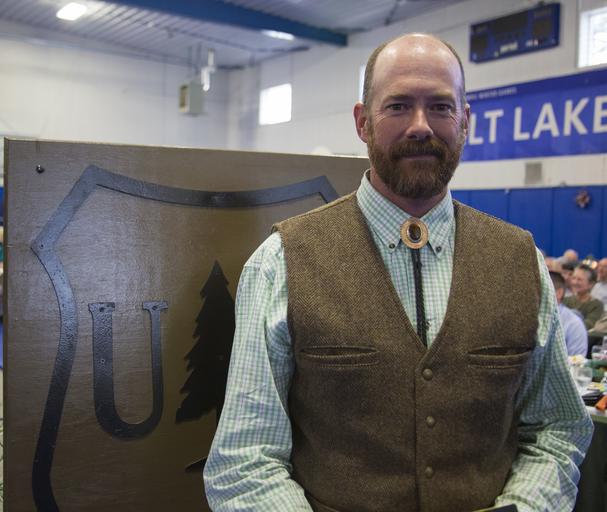MAKE A MEME
View Large Image

| View Original: | Chad_Hayward_Meeting_Americas_Needs.jpg (4517x3812) | |||
| Download: | Original | Medium | Small | Thumb |
| Courtesy of: | www.flickr.com | More Like This | ||
| Keywords: people Chad Hayward Big Piney Ranger District Bridger-Teton National Forest In recognition of your innovation and commitment to provide the American people with a reliable supply of rangeland and improved vegetation for wildlife and recreation for present and future generations. In late June2012, the Fontenelle Fire torched the trees and shrublands of the Bridger-Teton National Forest’s Big Piney Ranger District. The 64,000 acre forest scorched grazing allotments for six forest permitees. The likely necessity to rest the allotments for several years after such a burn and require animals to stay off the grazing area could spell financial ruin for the livestock permittes who make their living off of the grazing operations. The innovation of Bridger-Teton National Forest employee Chad Hayward saved the permitees from losing their livelihoods. Hayward’s responsibility was to restore the post-fire landscape and get the forest to once again cycle nutrients, capture carbon and filter water while also providing the cattle something to eat. Hayward called colleagues in federal, state, local and non-government organizations. He secured unused pastures on Wyoming Game and Fish habitat management area, and on vacant unburned Forest parcels. He also found permittess on unburned leases who offered to allow his neighbor to share some of his pasture. Hayward pulled together enough grazing land for all six permittees who had lost their allotments in the Fontenelle Fire. Next, he brought together a consortium of federal, state, and local partners to restore the forage and other plants on the burned pasture. The Wyoming Game and Fish monitored the vegetation to assess the return of native plants and catch weed infestations. The Rocky Mountain Elk Foundation and Wyoming Landscape Conservation Initiative funded weed treatments. The Wyoming Wildlife and Natural Resource Trust and Exxon pitched in to replace the burned fences. The restoration aimed to promote aspen regrowth and provide lots of high quality forage for livestock in the understory. The fire restoration was so successful that the country opened up and had fewer weeds. The forage is so vigorous, that it can now support more cattle than it did before the fire. The relationships forged amongst the landowners, government agencies, and ranchers set the Forest up for this successful collaboration and teamwork. The flexibility and innovation of Hayward assured that multiple use of the natural resources was cemented in his pursuit to care for the land and serve people. Chad Hayward Big Piney Ranger District Bridger-Teton National Forest In recognition of your innovation and commitment to provide the American people with a reliable supply of rangeland and improved vegetation for wildlife and recreation for present and future generations. In late June2012, the Fontenelle Fire torched the trees and shrublands of the Bridger-Teton National Forest’s Big Piney Ranger District. The 64,000 acre forest scorched grazing allotments for six forest permitees. The likely necessity to rest the allotments for several years after such a burn and require animals to stay off the grazing area could spell financial ruin for the livestock permittes who make their living off of the grazing operations. The innovation of Bridger-Teton National Forest employee Chad Hayward saved the permitees from losing their livelihoods. Hayward’s responsibility was to restore the post-fire landscape and get the forest to once again cycle nutrients, capture carbon and filter water while also providing the cattle something to eat. Hayward called colleagues in federal, state, local and non-government organizations. He secured unused pastures on Wyoming Game and Fish habitat management area, and on vacant unburned Forest parcels. He also found permittess on unburned leases who offered to allow his neighbor to share some of his pasture. Hayward pulled together enough grazing land for all six permittees who had lost their allotments in the Fontenelle Fire. Next, he brought together a consortium of federal, state, and local partners to restore the forage and other plants on the burned pasture. The Wyoming Game and Fish monitored the vegetation to assess the return of native plants and catch weed infestations. The Rocky Mountain Elk Foundation and Wyoming Landscape Conservation Initiative funded weed treatments. The Wyoming Wildlife and Natural Resource Trust and Exxon pitched in to replace the burned fences. The restoration aimed to promote aspen regrowth and provide lots of high quality forage for livestock in the understory. The fire restoration was so successful that the country opened up and had fewer weeds. The forage is so vigorous, that it can now support more cattle than it did before the fire. The relationships forged amongst the landowners, government agencies, and ranchers set the Forest up for this successful collaboration and teamwork. The flexibility and innovation of Hayward assured that multiple use of the natural resources was cemented in his pursuit to care for the land and serve people. | ||||